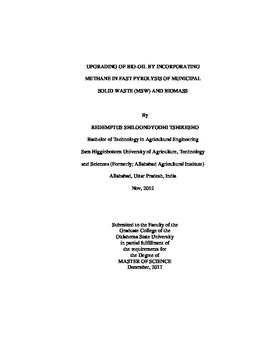| dc.contributor.advisor | Kumar, Ajay | |
| dc.contributor.author | Tshikesho, Redemptus Shiloondyodhi | |
| dc.date.accessioned | 2018-06-25T16:31:29Z | |
| dc.date.available | 2018-06-25T16:31:29Z | |
| dc.date.issued | 2017-12-01 | |
| dc.identifier.uri | https://hdl.handle.net/11244/300321 | |
| dc.description.abstract | Fast pyrolysis is promising technology that produces liquid fuels (known as bio-oil) through thermal decomposition of biomass or municipal solid waste in absence of oxygen. Bio-oil has potential application in the transportation sector. However, because of its unwanted properties (such high oxygen, acidic, and low energy) that are detrimental to current infrastructures, bio-oil can be used directly without being upgraded. This study was focused on addressing these undesirable properties of bio-oil by introducing methane over catalysts (HZSM-5 and MoZn/HZSM-5) during fast pyrolysis. A fixed bed and pyroprobe reactors were employed to investigate effects of methane, temperature and catalyst on the weight yield, energy recovery, chemical composition and aromatic hydrocarbons yield of bio-oil from eastern red cedar and municipal solid waste. In chapter II, eastern red cedar pyrolysis experiments were carried out using both reactors under methane and helium over both catalysts at 650 and 750?. Chemical composition and energy content were analyzed in gas chromatography/mass spectrometry and bomb calorimeter, respectively. The maximum bio-oil yield of 53.4 wt% and energy content of 10.2 MJ/kg achieved when methane was used over MoZn/HZSM-5 at 650?. This indicated that introduction of methane in fast catalytic pyrolysis of eastern red cedar improved the quality of bio-oil. MoZn/HZSM-5 improved aromatics hydrocarbon yield and a maximum of 56.8 area% was achieved at 750? under methane. Both catalysts considerably reduced oxygenated compounds at both temperatures of 650 and 750?. This showed that deoxygenation can be achieved in presence of methane over MoZn/HZSM-5. In chapter III, a pyroprobe reactor was employed to conduct a pyrolysis-gas chromatography/mass spectrometry (py-GC/MS) analysis of pyrolysis of municipal solid waste over both catalysts at 550, 650 and 750?. Carbon yield of aromatics hydrocarbons was increased from the maximum of 39.8% in non-catalytic to the highest yield of 56.8% under methane over MoZn/HZSM-5 at 650?. This showed that methane, a major component of natural gas which is abundant in natural gas reservoirs, is potential hydrogen donor for upgrading bio-oil during fast pyrolysis. | |
| dc.format | application/pdf | |
| dc.language | en_US | |
| dc.rights | Copyright is held by the author who has granted the Oklahoma State University Library the non-exclusive right to share this material in its institutional repository. Contact Digital Library Services at lib-dls@okstate.edu or 405-744-9161 for the permission policy on the use, reproduction or distribution of this material. | |
| dc.title | Upgrading of Bio-oil by Incorporating Methane in Fast Pyrolysis of Municipal Solid Waste (MSW) and Biomass | |
| dc.contributor.committeeMember | Apblett, Allen | |
| dc.contributor.committeeMember | Huhnke, Raymond L. | |
| osu.filename | Tshikesho_okstate_0664M_15407.pdf | |
| osu.accesstype | Open Access | |
| dc.description.department | Biosystems & Agricultural Engineering | |
| dc.type.genre | Thesis | |
| dc.type.material | text | |
